

Performance Comparison
: The Geforce2 MX400 vs. The Geforce2 Ti
January 10, 2002
by Mark Rubrico
Introduction
NVDIA, since the TNT2 days has somewhat spread there line of video card products to increase market share and attack all segments of the market. The TNT2 series, for example, had many "flavors", namely, the TNT2 Vanta, M64, so-called vanilla TNT2, TNT2 Pro and finally the TNT2 Ultra. Along with the costs, performance between these products varied widely. Instead of making it easier for the buyer, the whole plethora of products they offered often led to confusion. It was very confusing then, as it is now, to purchase an NVIDIA product. The Geforce line had only 2 flavors, though ( SDR and DDR ), but Geforce2 series has currently 7 different flavors!
With the Geforce2 line of cards, the MX was quite an attractive card. Unlike the TNT m64, this "crippled Geforce2" showed much more power than was expected of a value card. It was priced low but its performance wasn't that of of a typical value card. It delivered more than enough power for a card in its class. It was then considered have delivered the most bang for the buck . ( performed like the Geforce SDR at a fraction of the price ) Nvidia, also released two new chips after the MX, the MX400 and the MX200. The MX400 is essentialy the same as the original MX.
Although it was introduced just recently together with the new Geforce3 flavors, the Geforce2 Titanium still uses the same core as the GTS, Pro, and Ultra varieties of the original Geforce2 core. Like the MX400 is to the original MX, the Geforce2 Ti isn't much different to the Geforce2 Pro. ( MX and MX400 share the same memory clock, 166mhz ; Pro and Ti, 400 mhz)
For people looking for a budget card the MX400 is priced very attractively. It is not unusual to see its more powerful brothers ( GTS, PRO, Titanium, Ultra ) costing more than twice the MX400. This article will focus on the performance of the MX400 and the Geforce2 Ti. Will the MX400 be able to keep up with its much more powerful sibling? Let's see.
Listed at the table below are the specs for the whole Geforce2 family. No less than seven different card bear the Geforce2 name.
|
|
Geforce2
MX00
|
Geforce2
MX
|
Geforce2
MX400
|
Geforce2
GTS
|
Geforce2
PRO
|
Geforce2
Titanium
|
Geforce2
Ultra
|
|
Core
Clock
|
175
|
175
|
200
|
200
|
200
|
250
|
250
|
|
Mem
Clock
|
166
|
166
|
166
|
166
|
400
|
400
|
460
|
|
Mem
Type
|
64bit
SDR DRAM
|
128bit
SDR DRAM
|
128bit
SDR DRAM
|
128bit
DDR DRAM
|
128bit
DDR DRAM
|
128bit
DDR DRAM
|
128bit
DDR DRAM
|
|
Rendering
Pipelines
|
2
|
2
|
2
|
4
|
4
|
4
|
4
|
|
Pixel
Fillrate
|
350
MPixels
|
350
MPixels
|
400
MPixels
|
800
MPixels
|
800
MPixels
|
1.0
GPixels
|
1.0
GPixels
|
|
Texel
Fillrate
|
700
MTexels
|
700
MTexels
|
800
MTexels
|
1.6
GTexels
|
1.6
GTexels
|
2.0
GTexels
|
2.0
GTexels
|
|
Bandwidth
|
1.3
GB/s
|
2.7
GB/s
|
2.7
GB/s
|
5.3
GB/s
|
6.4
GB/s
|
6.4
GB/s
|
7.3
GB/s
|
Specifications for the Geforce2 line of chips
Focusing on the MX400, we see that the only difference between it and the original Geforce2 MX is the clock of the GPU core. Sporting 25 more mhz than its its brother, the MX400 pushes up its fillrate upto 800MTexels. We also notice that the Geforce2 Titanium is a Pro and Ultra hybrid. Having the core clock of the Pro and the Memory clock of the Ultra, the Titanium should perform just between them ( much closer to the PRO, because of bandwidth issues).
We see that the starting from the core clock down to the bandwidth the Geforce2 Ti leads the MX400 specs-wise. The MX400's fillrate is only a fraction to that of the Ti's. And both its core clock and memory clock are nowhere near that of the Geforce2 Ti's. Add the fact, that the MX400 has only half the number of rendering pipelines its seems that it has no chance of catching up with the Ti.
The cards
Both the Geforce2 MX400 and and the Geforce2 Titanium cards were Inno3d products. The Inno3d Tornado Geforce2 Titanium was clocked at its default speed. It featured a core clocked at 250 mhz and 64 Megabytes of 400 Mhz ( DDR ) memory. Surprisingly, the Inno3D Geforce2 MX400, had its memory ( 32 Megabytes ) clocked at 184 mhz, instead of the default 166 mhz. This is a full 10% memory overclock from the NVIDIA specification! Of course a 10% increase in bandwidth is a big bonus since the MX400 is quite bandwidth limited to begin with. The MX400's core was clocked at 200 mhz at default following NVIDIA's specifications.
|
Inno3D
Geforce2 MX400
|
Inno3D
Geforce2 Titanium
|
|
|
Default
Core Clock / Memory Clock
|
Core : 200 Mhz Mem : 184 Mhz |
Core : 250 Mhz Mem : 400 Mhz |
|
Default
Fillrate
|
Pixel : 400 Mpixels Texel :800 Mtexels | Pixel : 1 Gpixels Texel : 2 Gtexels |
|
Default
Bandwidth
|
2.944 GB/s | 6.4 GB/s |
|
Overclocked
Core Clock / Memory Clock
|
Core : 220 Mhz Mem : 215 Mhz |
Core : 280 Mhz Mem : 465 Mhz |
|
Effective
Fillrate
|
Pixel : 440 Mpixels Texel :880 Mtexels | Pixel : 1.12 Gpixels Texel : 2.24Gtexels |
|
Effective
Bandwidth
|
3.440 GB/s | 7.440 GB/s |
The chart above shows how much the cards were overclocked. The cards overclocked bit higher than those numbers ( 230/220 for the MX400 and 290/480 for the Geforce2 ti ) but they were dropped back to those numbers above when even the slightest artifacts were noticed.
The Inno3d Geforce2 MX400's memory overclocked to 215 Mhz from its default 184 Mhz, almost a 17% increase. Compared to the NVidia default specification for an MX400's memory clock ( 166 Mhz), this is over 30% faster! The Inno3D MX400's core toppled out at 220Mz, a 10% overclock. However, since these cards are being limited by there bandwidths even before saturating there fillrates, an increase in bandwidth ( Memory ) will deliver more performance.
With a 12% increase in its core clocked when overclocked, the GeForce2 Ti's fillrate is upped to an impressive 1.12GPixels ( 2.24 GTexels ). And though its 16% memory overclock ( from 400 to 465mhz ) is only about half as much as the MX400's overclock, it enables the Geforce 2 Ti to perform at Ultra levels. Which will be very handy when it comes to high resolution and FSAA gaming ( being both bandwidth intensive ).
Benchmarking Setup
All test were doing using Nvidia's Detonator v. 21.85. The benchmarks were run on WinXP and overclocking of the cards were done using the coolbits registry hack. All other grahic settings were left to default.
The system that tests were run on feature a AMD Duron 700 clocked at 6.5x146 ( 950 Mhz ) sitting on an IWill KK266 motherboard. With 1 256MB PC133 and 1 128MB PC133 ram, running on conservative memory settings.
When testing for overclocking, both cards were pushed to the maximum until they either showed artifacts ( corrupted image quality ) or literally stopped working. The system was reset and then the cards were tested on both higher and lower settings till they worked flawlessly. The cards overclocked a bit higher than those settings used but for safety and stability issues they were, "throttled down" a bit.
Quake 3 Benchmarks

We start off by running Quake 3 at its "high quality" setting with the resolution brought down to 640x480 from its default 800x600. Here both the Geforce2 Ti and the Geforce2 MX400 aren't loaded enough to really tax there fillrates ( and memory bandwidth ). Even when overclocked, the MX and the Ti really gain no tangible performance increases. At a resolution this low, performance is limited by the platform ( CPU + Memory ) the game is running on.
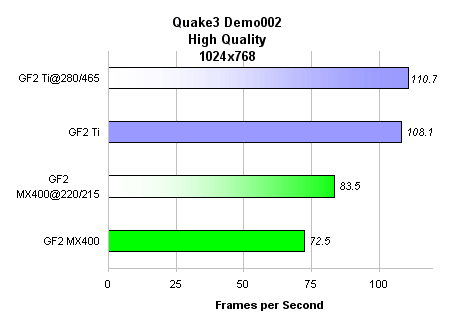
Still at a color depth of 32bit, we begin to see how the Geforce2 Ti begins to pull way from the MX400. The Geforce Ti is a 50% faster at this resolution when compared to the MX400. Even when overclocked the Geforce Ti still has a 30% lead over the MX400, which is already beginning to show its bandwidth limitations at this resoluton.
Overclocking the MX400 increases its performance by 15% percent. Which closely matches its 16% increase in memory bandwidth. ( default memory clock 184Mhz, increased to 215Mhz ).
The Geforce2 Ti however, is unaffected by overclocking. Only showing that 6.4GB/s of bandwidth provided by its 200Mhz DDR SDRAM ( 400Mhz effective ) is more than enough to run this game at this resolution ( 1024x769 ) and color depth ( 32bit ).
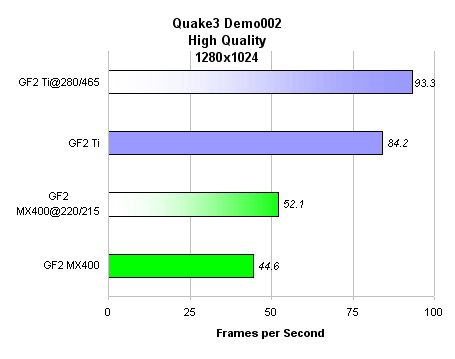
The Geforce2 Ti is 88% faster than the MX400 at this resolution! And is 61% faster than the overclocked MX400. We see that the MX400 begins to be hampered by its limited bandwidth at resolutions above 1024x768 in quake 3.
Overclocking the MX400 at this resolution ( 1280x1024 ) gives it approximately 17% more "power". Which really helps! The Geforce2 Ti also gains a decent 10% from overclocking.
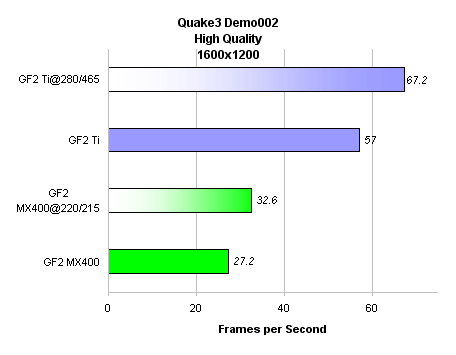
Playing Quake3 at 1600x1200 ( 32 bit ) is simply not an option for the MX400. The Geforce2 Ti delivers more than twice the frame rate the MX400 has to offer. And even the impressive 20% performance gain from overclocking wont help the MX400 perform acceptably in this very high resolution.
The GeForce2 Ti also gains quite a bonus from overclocking. An added 18% definately wont hurt. Overclocking the Geforce2 Ti enables it just to go beyong the 60fps mark, which to a so-called "hardcore gamer" is the absolute minimum frame rate to be considered "playable.:
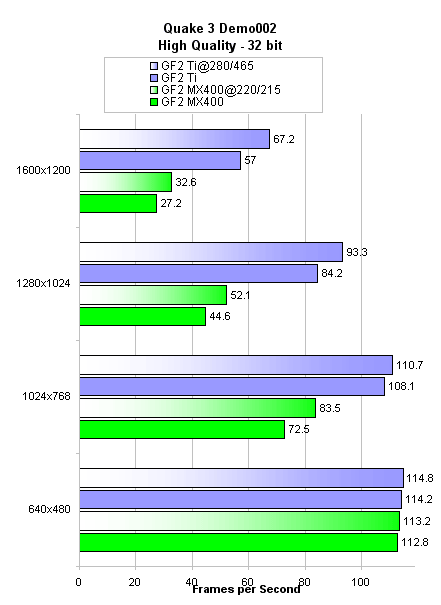
The performance of the MX400 and the Geforce2 Ti is shown above with varying resolutions. At 1024x768 ( 32 bit Color Depth) the MX400 begins to trail the Geforce2 Ti. With less than half the available bandwidth of the Geforce2 Ti, the MX400 simply can't keep up with the Geforce2 Ti as the resolution is cranked up some more.
Going from 640x480 to 1024x768, the MX400 suffers a drop in frame rate of 35%! An overclocked MX400 however cuts back the loss to 26%. The raw power of the Geforce2 Ti however enables it to lose only 5% and only 3% when overclocked.
As the resolution goes up to 1280x1024 ( from 1024x768 ), the MX400 suffers another huge loss in frame rate ( 39% ). Overclocking it really helps as a hefty 16% performance is gained. The Geforce2 Ti on the other hand, suffers a 22% decrease in frame rate when the resolution was bumped.
Finally when the resolution is upped the for the last time, the MX400's performance is down to 27.2 frames per second. A full 39% decrease from the previous resolution ( 1280x1024 ). The powerful Geforce2 Ti too, begins to buckle as it loses 32% of its performance.
Frames above Everything Else?
Insanely high frame rates may very well prove to be useless to most people. Specially when you are averaging well beyond a hundred frames per second and consistently getting very high minimum frame rates. Excessively high frame rates are practically useless.

For example, at 1024x768x32bit on the High Quality Setting of Quake3, the MX400 is performing very admirably! Averaging well over 60 frames per second, the MX400 is performing 20% faster than what some people ( HARDCORE GAMERS ) consider to be the acceptable frame rate. Some people ( avid gamers ) aren't able to differentiate a game running at 60 frames per second to a game running at 30 frames per second!
Running games at 1024x768 ( and 32 bit color depth ) is slowly becoming the standard nowadays. This resolution is what most people consider the "sweet spot" to run there games on. Running at resolutions above 1024x768x32 wont make much difference for most people, who dont own very large monitors ( 19+ inches )
Considering that MX400 delivers more than enough frames per second when running Quake3 at 1024x768x32, suddenly makes the Geforce2 Ti a very unattractive product, price wise. Why pay more than twice the price for the Ti, when it will deliver an unnoticeable ( overclocked MX 83.5 fps, Geforce2 Ti 108.1 fps ) increase in performance over the MX400. ( at these settings, games, resolution and platform ).
Full Screen Anti-Aliasing ( FSAA )
When playing at a relatively low resolution, it is sometimes not too difficult to notice that lines ( diagonal ) exhibit a staircase effect. This is caused by the lack of number of pixels to represent a line. Cranking up the resolution somewhat lessens the effect. But surprisingly, even at 1600x1200 aliasing of those "jaggies" are still noticeable!
There are many ways to rid lines of those jaggies. With the Geforce, Geforce2 line of cards Nvidia uses what is called "supersampling". This is done by rendering a scene at 2x or 4x its resolution, and then bringing it back to the original resolution. Some sort of blending ( really averaging of subpixels color values ) is performed on adjacent pixels to effectively smoothen the line. To better illustrate this effect, here are some screen shots from Quake3 demo. ( the F11 button was used on Quake3 )

It is very clear on the series of screen shots taken that the jaggies on the statue's arms back and hair are removed through anti-aliasing. The 2X FSAA setting dramatically improves the picture quality of image. And the 4x FSAA further reduces the jaggies to the point that they are barely noticeable anymore. This shots were taken at 1024x768x32.
As with everything else, FSAA comes with a price. Since rendering at 2x and 4x effectively doubles and quadruples the number of pixels rendered on the chip ( fillrate and bandwidth limitations are amplified ) , a tremendous performance drop can be expected. Yes, FSAA looks good, but how much penalty are we talking about here. Let's move on.
FSAA Peformance
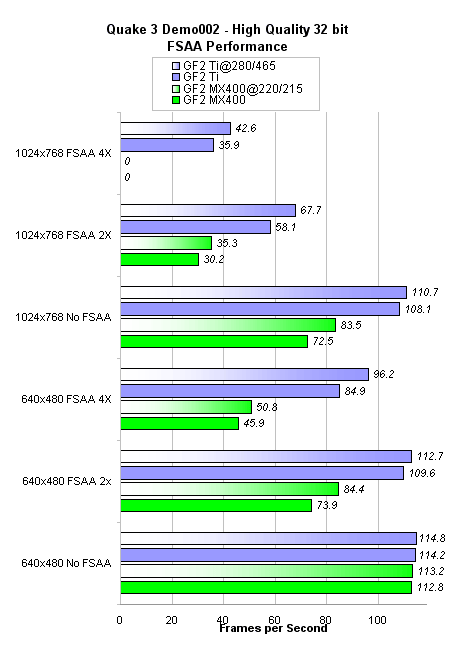
At 640x480x32 2X FSAA, the MX400 loses 34% ( of its performance. And although going to 4X FSAA ( from no FSAA ) makes the MX400's performance plummets by 60%, 45.9 frames per second is still very playable. Quake3 running 640x480x32 4X FSAA is definately playable on the MX400. Plus overclocking it gives a decent 10% boost.
The Geforce2 Ti on the other hand, virtually doenst experience a drop when going to 2X FSAA. At 4X FSAA however it suffers a 27% loss in frame rate drop. Overclocking the Geforce2 Ti offers no tangible performance gain on the 2X FSAA setting, on the 4X FSAA setting it gains just over a 13% frames per second.
Bumping the resolution to 1024x768x2, greatly degrades the performance of both cards. Here we see the MX400 perform at less than half of its original frame rate when switching to 2X FSAA. Bandwidth requirements begin to greatly hamper the MX400's performance. Its drop from 72.5 frames per second to 30.2 frames per second, equates into a 58% loss! A 17% performance gain from overclocking helps a little, but at 35.3 frames per second it still isn't performing well, in these particular game ( Quake 3 ). The MX400 simply doesnt have enough horsepower ( bandwidth ) to allow 4X FSAA this resolution. If running 4X FSAA on 1024x768x32, had not been disabled in the drivers ( Det. 22.50 ) the MX400 would deliver single digit frame rates here.
With FSAA turned off, the Geforce2 Ti delivers an incredible 108.1 frames per second at 1024x768x32. Only showing how much power this card holds. However we immeditely see a huge drop in performance ( 46% drop ) as we turn on the 2X FSAA setting. It's still very playable at 2X FSAA especially when overclocked. The next step however really makes the Geforce2 Ti kneel on its knees. Switching to 4X FSAA ( from no FSAA ) reduces its performance by an alarming 67% at 35.9 frames per second. Overclocking the Geforce2 Ti really gives the performance it needs, especially at the 4X setting where it got a very respectable 42.6 frames per second.
Direct 3D Performance
3dMark has long been the standard in synthetic benchmarking using Microsoft's API, Direct 3D. With each succeeding version, it seems that benchmark gets more and more resource intensive. 3dMark 2001, in particular, is as much dependent on the brute power of the CPU as it is on the video card. The results in the games benchmarks were taken from there "low" setting, since at the higher setting values for the cards were in the teens and rarely varied, hinting that the Duron 700@6.5x146 ( 950 mhz ) used, wasn't enough for the benchmark.
It is also important to note, that 3d Mark is considered "ahead of its time".
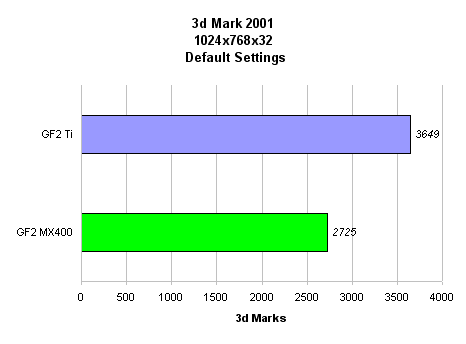
3dMark 2001 run in the default settings: at 1024x768x32bit. The Geforce2 Ti leads ( by 34% ) in the overall 3dmark benchmark, which is represented by a "3dmark score". It really is hard to imagine what several thousand of 3dMarks mean in terms of performance. Games 1 ( Chase ) and Games 3 ( Lobby ) which are part of the 3dmark2001 run are used in the following charts to represent a little more than just synthetic numbers.
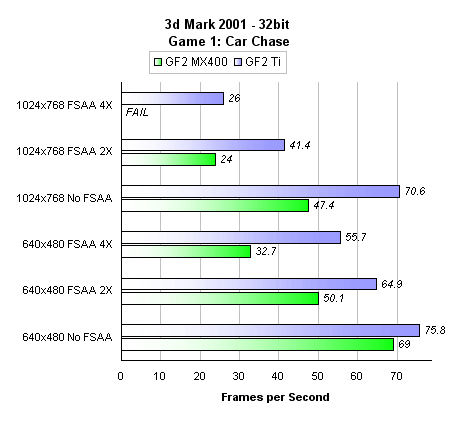
At 640x480x32 the Geforce2 Ti manages to gain a small lead ( less than 10% ) over the MX400. Both are pushing frame rates pretty good, considering how much intesive this benchmark is. Going up a notch, at 1024x768x32, the MX400 suffers a 31% decrease in its performance, delivering a fair 47.4 frames per second. With 70.6 frames per second. Geforce2 Ti has a lot more power to spare dropping only 6%, beating the MX400 by almost 50%.
Firing up 2X FSAA, the MX400 loses 27% of its original frame rate at 640x480x32 ( 69 -> 50.1 frames per second ), while the Geforce2 Ti suffers less "damage" with a 14% loss. At 1024x768x32 with 2X FSAA turned on, the MX400 loses half of its frame rate, dipping to just 24 frames per second. The Geforce2 Ti gets a beating too, losing 30% of its performance, although 41.4 frames per second is still playable.
When 4X FSAA is used both cards really come to a crawl. At the lower resolution, 640x480x32, the MX400 plunges 52%, deliviring only 32.7 frames per second. Pushing close to 60 frames per second the Geforce2 Ti, still provides very good frame rates, even though it has already dropped 26% of its performance. Finally at 1024x768x32 the MX400 simply "fails" as it refuses to do 4X FSAA at this resolution. The Geforce2 Ti too, isnt offering much at this setting.
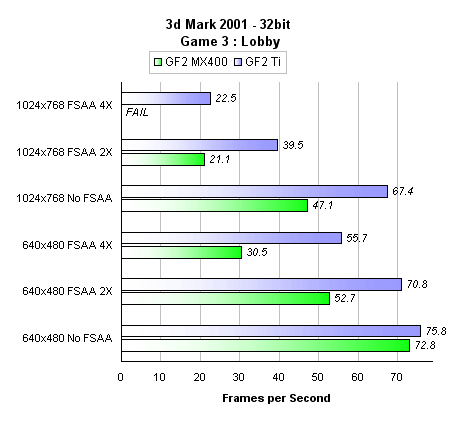
The same goes for Game 3 ( Lobby ), which resembles the lobby scene in the movie, Matrix. Frame rates are a tad smaller in this demo than in the car chase.
Vulpine GLMark
Vulpine GL Mark is an OpenGL benchmark, where in a demo is played composed of a couple of diffrent "scenes". At the start of the demo there is a very complex scene where a whole lot of coconut trees are rendered.
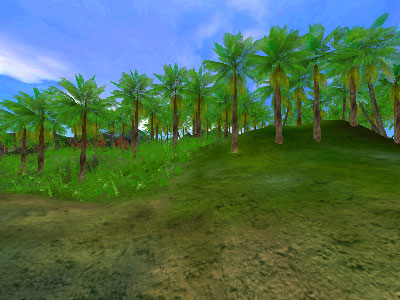
This is one of the scenes where the frame rate really drops, which isnt surprising considering the complexity of this particular scene. The settings below were used for benchmarking.
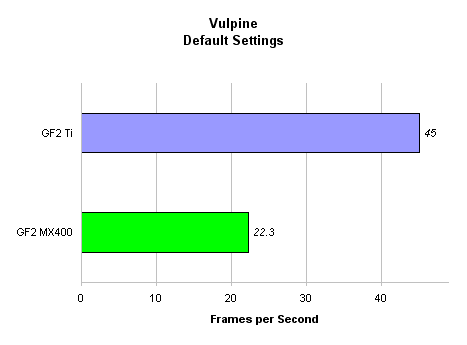
The Geforce2 Ti delivers twice as much frames per second than the MX400. This benchmark really pushes both cards!
16 Bit Performance
So far both this cards have been battling it out on several different resolutions. The MX400 keeps up with its younger brother on lower resolutions. As soon at the resolution is cranked up and/or FSAA is used, the MX400, with its limited bandwidth, begins to perform rather poorly. It may seem obvious: Get the MX400 and play at relatively low resolutions; or Get the Geforce2 Ti and play at higher resolutions. And avoiding the MX400 if FSAA is to be used ( at least, 4X that is ).
One way to "avoid" being bandwidth limited with the MX400 is to overclock the memory. But overclocking has its limits too, even with the impressive 17% memory overclock, the Inno3d MX400 is still in need of more bandwidth. Another way is to decrease the amount of information that the MX400 needs to handle. Switching from 32bit to 16bit, halves the amount of memory needed, making it ideal for the bandwidth starved MX400 ( specially on high resoultions ).
This, of course, introduces image quality issues. This shot was taking on Quake3, it is clear that 32bit looks much better than 16bit. The shots are jpeg compressed so some degradation has occured. The 32bit image shows the transparent bubble clearly, unlike the 16bit one. However, if the performance increase is large enough, then it may be worth switchin to 16 bit. Let's see...
|
16 Bit |
32 bit |
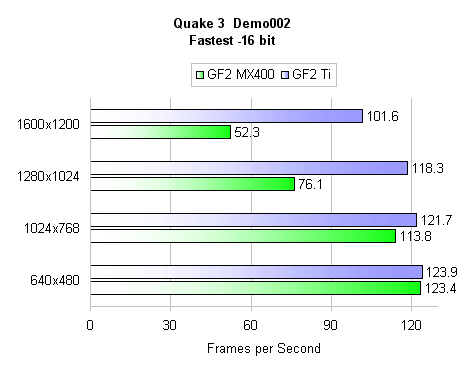
Using the "Fastest" setting on Quake3, we see the MX400 delivering very impressive frame rates! Even at 1600x1200 it still runs like charm. From 640x480x16 to 1024x768x16 both cards suffer virtually no performance decrease. At 1280x1024 even if the MX400 drops 33% it still packs quite a punch! Up another notch to 1600x1200, the MX400 suffers yet another 31% drop, indicating that its becoming bandwidth limited once again. of course, averaging 52.3 frames per second at 1600x1200 is not bad at all!
The Geforce2 Ti averages over a hundred frames per second from 640x480x16 up to 1600x1200x16. Performing almost twice as fast as the MX400 at the highest resolution, The Geforce2 Ti simply overpowering the MX400.
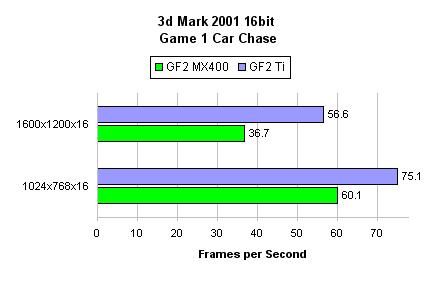
Starting out this time at 1024x768, the Geforce2 Ti has a 25% lead on the MX400. Also at 1600x1200x16 The Geforce2 Ti performs 54% higher than the MX400.
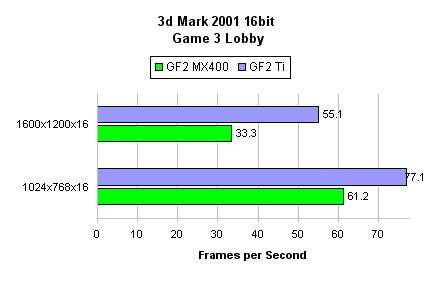
The way both cards behave at Game 3 : Lobby is very similar to there first game on 3d Mark 2001. The MX400 is still around 49% slower than the Geforce2 Ti at 1600x1200x16.
16 Bit FSAA
At a color depth of 32Bit the MX400 could not deliver high frame rates at 1024x768, compared to the Geforce2 Ti. Now with the Settings at Quake3 switched to 16 bit ( fastest ) well see how both cards perform with FSAA.

The MX400 performs very well with FSAA on this resolution! Delivering an astouding 75 frames per second on 4X FSAA! The Geforce2 Ti practically doens't drop its frame rate switching from No FSAA, to 2X FSAA and finally 4X FSAA.
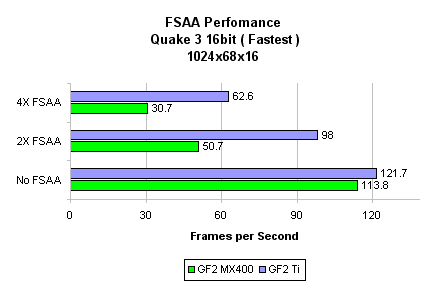
Upping the resolution by 60% ( 640x480 -- > 1024x768 ) both cards feel the need for more bandwidth. The MX400 suffers a huge 58% drop in its frame rate when switching to 2X FSAA. The Geforce2 Ti too isnt saved, losing almost 20% when switching to 2X FSAA. Even with such a large hit for the MX400, it still is very playable at 1024x768. At 4X FSAA however, it delivers less than half of its sibling's frame rate, making gameplay a bit "choppy".
16 bit vs. 32 bit Performance
Full Screen Anti-Aliasing is very playable with the MX400 on 16 bit mode. The difference ( frame rate ) of the 32 bit and 16 bit FSAA ( and non-FSAA )modes however have not been presented in detail. Instead of having to compare one chart to another, combining both graphs that shows the performance of both modes ( 16bit and 32bit ) side by side would make it easier "visualize" the performance delta.
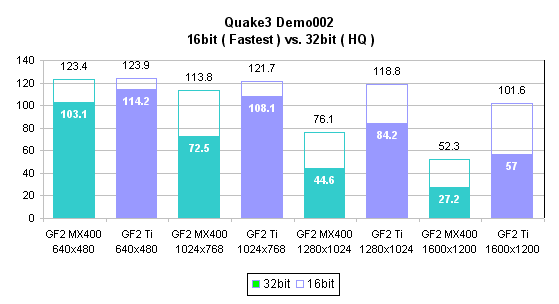
We start off with Quake 3 with several different resolutions.
The solid bar represents the 32bit performance, while the 16bit performance is represented by the clear bar. Also, the purple bars represents the Geforce2 Ti's performance and the the teal ones belong to the MX400.
At 640x480 switching to 16 bit boosts the MX400's frame rate by 20% The Geforce2 Ti gains less than 10%. On 1024x768 close to 60% is gained by the MX400 when switching to 16 bit ( fastest ). The Geforce2 Ti, still delivering over a hundred frames per second on either modes, "steals" a small 12% when switching to 16 bit.
On higher resolutions the MX400's gains skyrocket when switching to 16bit. At 1280x1024 switching to 16 bit enhances the MX400's performance no less than 70%! And who'd have ever think that the MX400 could be playable at 1600x1200? Increasing from 27.2 frames per second to 52.3 frames per second when dropping from 32 bit ( 92% increase ) , makes the MX400 a lot more playable.
At 1280x1024, the Geforce2 Ti, like the MX400, appreciates a switch to 16 bit ( gain of 41%). It also breaks the 100 frames per second mark when switching. At the next resolution, 1600x1200, switching to 16 bit, again, enables the Geforce2 Ti to break the 100 fps barrier.
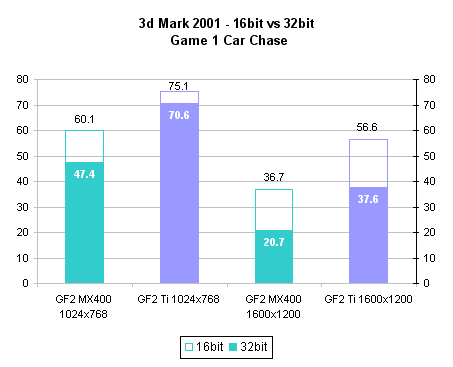
At 1024x768 the MX400 gains 27% when switching, while the Geforce2 Ti gains a mere 6%. At 1600X1200, the MX400 gains an impressive 77% when switched to 16bit. The Geforce2 Ti gains 50% pusing its performance to 56.6
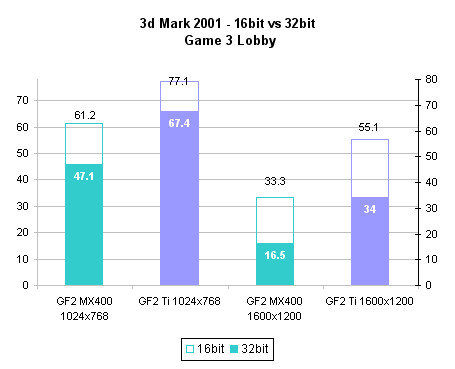
Game 3 : Lobby results are similar to the first 3dMark2001 game.
Unlike the settings used in Quake 3, where the "quality" switch involved many factors ( e.g. texture quality, bilinear/trilinear filtering, lighting ), the 3dMark 2001 chart is a purely color depth ( 16 bit to 32 bit ) change.
FSAA performance 16bit vs. 32bit
The FSAA numbers should show large increases when switching from 16bit to 32bit because running 2X and 4X FSAA modes, effectively multiplies the current resolution by 2 and 4, respectively. ( e.g. 4X FSAA at 640x480 = 1280X960 ). Rendering at the effective resolution, therefore, tends to reveal bandwidth limitations more readily.
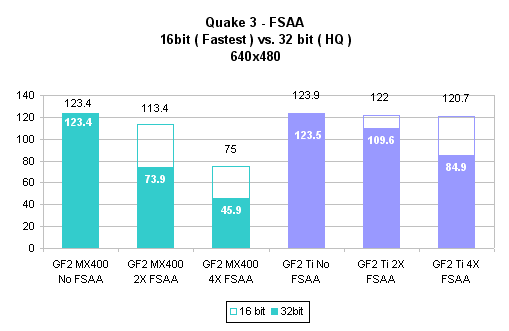
At 640x480 with FSAA off, the MX400 doesn't benefit from the switch to 16bit from 32bit. Its fillrate nor its bandwidth isn't really taxed at this resolution without FSAA. As soon as FSAA is used, the MX400 benefits greatly if color depth is reduced to 16bit. At 2X FSAA a huge 53% is gained by the MX400 when switching to 16bit. The same thing happens with 4X FSAA, where its performance increases to 75 frames per second.
Like the MX400, the Geforce2 Ti, doesn't experience and performance bonus when switching to 16bit. Even when in the 2X FSAA setting, it gains "only" 10% when dropping down to 16bit. It does, however, perform 30% slower when using 32bit, at the 4X FSAA setting.

Increasing the resolution to 1024x768, we see very different results. The MX400 performs very well when switching to 16 bit at this resolution. Immediately noticeable are the FSAA modes. At 32bit the MX400's drivers refuse to allow FSAA modes on 1024x768. Simply switching it to 16 bit mode allows it to do FSAA on this resolution. And its results are quite respectable. The 2X FSAA setting isn't to bad, with 50.7 framesper second. And although, switching to 4X FSAA ( at 16bit ) makes frame rate a bit low, its still is better than its 32bit results! With no FSAA, its performance goes up by 57%!
Even at 1024x768x32 ( NO FSAA ) the Geforce2 Ti still has the raw power to allow it to surpass the 100 frames per second mark. At 2X FSAA the Geforce2 Ti, gains fa hefty 69% when switching to 16 bit. And at the 4X FSAA setting gains an even larger, 74% going just over 60 frames per second on 1024x768 4X FSAA.
Switching to 16 bit really helps both cards perform significantly better in al,l but the lowest resolutions. Also FSAA modes can be very playable on the MX400 if 16bit is used. The Geforce2 Ti too, can benefit greatly when 16bit is used alongside FSAA modes. Besides FSAA, both cards gain a huge increase in performance when using 16bit on really high resolutions. ( bandwidth intensive )
Conclusion
The Geforce2 MX400 proves to be quite a decent card. Although it can't keep up with the Geforce2 Ti on higher resolutions and it performs very admirably on lower resolutions. As soon as FSAA is turned on, however, the MX400's performance becomes disappointing. With "only" 2.944 GB/S of bandwidth available, the Inno3d Geforce2 MX400, benefits from the switch to 32 bit down to 16 bit. In this reduced color depth it can deliver very acceptable frame rates, even when using FSAA. With its memory being able to clock more than 30% from NVidia's specs for an MX400, the Inno3d Geforce2 MX400 easily gets the most bang for your buck!
The Inno3d Geforce2 Ti, although not being able to overclock that high, is also a great card. It went well past the default Ultra speeds when overclocked. And it consistently overwhelmed the MX400 on higher resolutions/FSAA ( where the MX400's framerates would be considered unplayable to some).Like the MX400 dropping to 16bit also greatly helps its performance. Gaming benchmarks aside, the Geforce2 Ti's 2D ( at 1280x1024@85hz ) quality noticably better than the MX400's.
To sum it all up the tables below is show how well the MX400 stacked up against the Geforce2 Ti ( relative performance of MX400 ).
| 640x480 | 1024x768 | 1280x1024 | 1600x1200 | |
| Geforce2 MX400 | 123.4 | 113.8 | 76.1 | 52.3 |
| Geforce2 Ti | 123.9 | 121.7 | 118.3 | 101.6 |
| Relative Peformance of MX400 ( Ti = 100% ) |
~100%
|
93%
|
64%
|
51%
|
|
640x480
|
1024x768
|
1600x1024
|
|
| Geforce2 MX400 | 112.8 | 72.5 | 27.2 |
| Geforce2 Ti | 114.2 | 108.1 | 57.0 |
| Relative Peformance of MX400 ( Ti = 100% ) |
98%
|
67%
|
48%
|
|
No FSAA 640x480 |
2X FSAA 640x480 |
4X
FSAA 640x480
|
|
| Geforce2 MX400 | 123.4 | 73.9 | 45.9 |
| Geforce2 Ti | 123.5 | 109.6 | 84.9 |
| Relative Peformance of MX400 ( Ti = 100% ) |
~100%
|
67%
|
54%
|
|
No FSAA 1024X768 |
2X FSAA 1024X768 |
4X
FSAA 1024X768
|
|
| Geforce2 MX400 | 72.5 | Fail | Fail |
| Geforce2 Ti | 108.1 | 58.1 | 35.9 |
| Relative Peformance of MX400 ( Ti = 100% ) |
67%
|
N/A
|
N/A
|
|
No FSAA 640x480 |
2X FSAA 640x480 |
4X
FSAA 640x480
|
|
| Geforce2 MX400 | 123.4 | 113.4 | 75.0 |
| Geforce2 Ti | 123.9 | 122.0 | 120.7 |
| Relative Peformance of MX400 ( Ti = 100% ) |
~%100
|
94%
|
62%
|
|
No FSAA 1024X768 |
2X FSAA 1024X768 |
4X
FSAA 1024X768
|
|
| Geforce2 MX400 | 113.8 | 50.7 | 30.7 |
| Geforce2 Ti | 121.7 | 98.0 | 62.6 |
| Relative Peformance of MX400 ( Ti = 100% ) |
93%
|
52%
|
50%
|